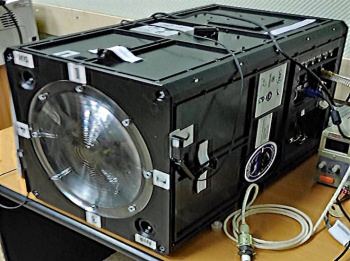
Italy’s National Institute for Nuclear Physics (INFN) has used Stratasys FDM 3D printing technology to produce the entire mechanical structure of a cosmic UV telescope for the International Space Station (ISS).
The Mini-EUSO telescope has been developed as part of an ad hoc bilateral agreement between the Italian Space Agency and the Russian Space Agency ‘Roscosmos’ and is set to study terrestrial and cosmic UV emissions from the ISS for the next three years. It was recently launched into space onboard a Soyuz rocket and successfully placed on an earth-facing window of the ISS’ Russian Zvezda module.
Harnessing Stratasys’ Fortus 450mc and ULTEM 9085 material, INFN were able to produce a telescope that could meet the stringent certification requirements of the aerospace industry and ISS, while also withstanding the mechanical stresses and vibrations during the launch of the Soyuz rocket. It also proved lighter than a previous aluminium prototype and also provided better insulation for the interior electrical currents.
“Using Stratasys FDM 3D printing throughout the production of the Mini-EUSO’s mechanical structure enables us to reduce the overall cost of the project by a factor of ten, as well as save us around a whole year of development time,” Marco Ricci, Lead Researcher at Laboratori Nazionali di Frascati INFN and INFN Country Manager for Collaboration EUSO SPB2 Italia. “It’s an incredible outcome for us that I have to say I never expected from 3D printing.”
The Mini-EUSO has been deployed on board the ISS to produce a high-resolution map of the Earth in the UV range (300-400 nm), serving to advance research on cosmic rays and as an important experiment for future space missions. It records all space and atmospheric objects within sight, which can include UV emissions from earth, transient luminous events, and meteors and other space debris.
“We are now in the process of analysing the first data recorded by Mini-EUSO and the results are very promising,” added Ricci. “From a researcher’s perspective, I’m extremely proud of the way the project was executed and very excited with the achievements. For me, it’s clear now how 3D printing can significantly contribute towards the future success and technological progress of scientific research.”
INFN has several Stratasys FDM machines located at its Laboratori Nazionali di Frascati (LNF) branch, and has also recently installed PolyJet capability.


